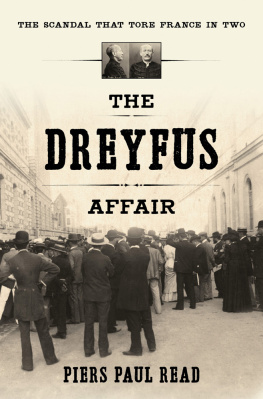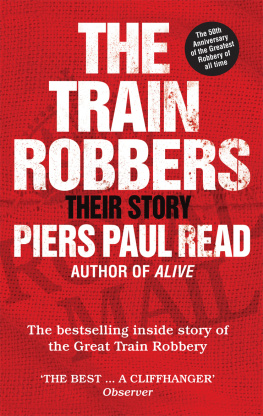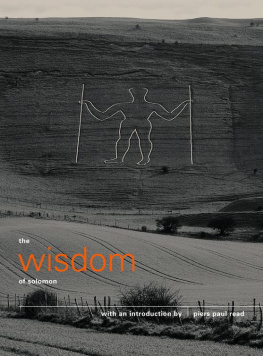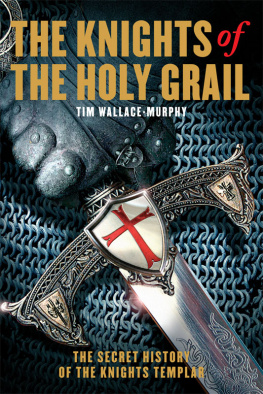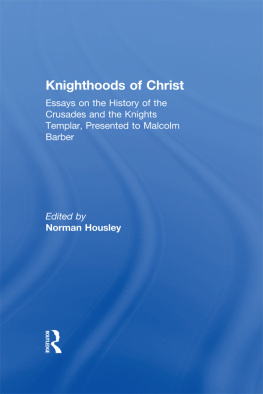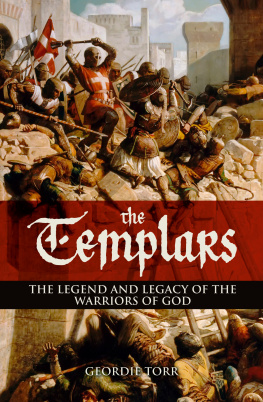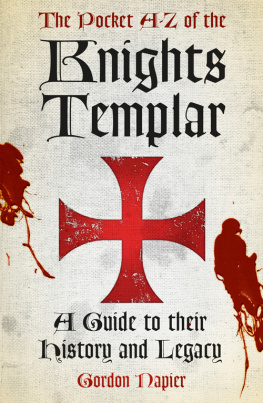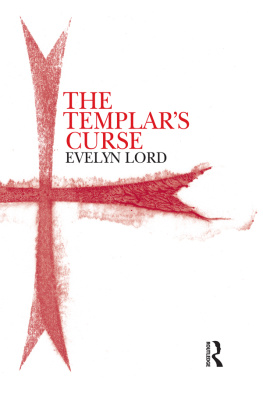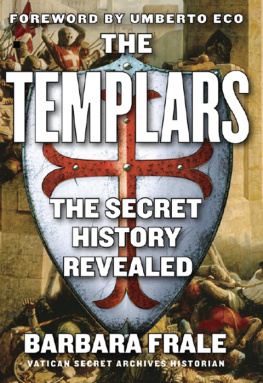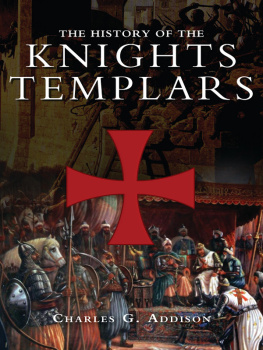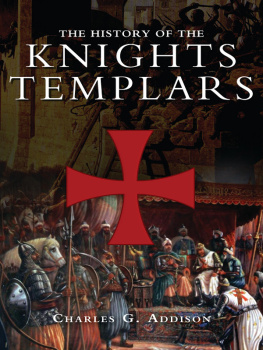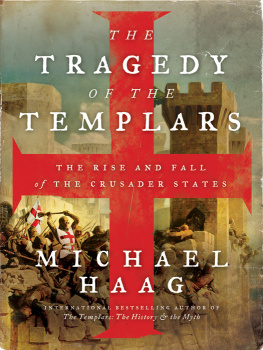Contents
Guide

The author and publisher have provided this e-book to you without Digital Rights Management software (DRM) applied so that you can enjoy reading it on your personal devices. This e-book is for your personal use only. You may not print or post this e-book, or make this e-book publicly available in any way. You may not copy, reproduce, or upload this e-book, other than to read it on one of your personal devices.
Copyright infringement is against the law. If you believe the copy of this e-book you are reading infringes on the authors copyright, please notify the publisher at: us.macmillanusa.com/piracy.
Contents
Acknowledgements
I am grateful for permission to reproduce passages from The Jewish War by Josephus, translated and with an introduction by G. A. Williamson, Penguin Books, 1959 (Copyright G. A. Williamson, 1959); The Rule of the Templars by J. M. Upton-Ward, The Boydell Press, 1992 (Copyright J. M. Upton-Ward 1992); and The Murdered Magicians by Peter Partner (Copyright Peter Partner 1981) by permission of A. M. Heath & Co. Ltd on behalf of Professor Peter Partner.
Maps
Preface
Who were the Templars? One view of this military order comes from the novels of Sir Walter Scott. The Templar knight in Ivanhoe, Brian of Bois-Guilbert, is a demonic anti-hero, valiant as the bravest of his Order; but stained with their usual vices, pride, arrogance, cruelty, and voluptuousness; a hard-hearted man, who knows neither fear of earth, nor awe of heaven. The two Templar Grand Masters are little better. Giles Amaury in The Talisman is treacherous and malevolent while Lucas of Beaumanoir in Ivanhoe is a bigoted fanatic.
In Wagners opera Parsifal, by contrast, Templar-like knights appear as the chaste guardians of the Holy Grail. The nineteenth-century libretto was based on the thirteenth-century epic poem by Wolfram of Eschenbach in which the Templeisen bear only a superficial resemblance to the Knights of the Temple but the germ of fact has been enough to persuade posterity that there is truth in the fiction. Thus, in the nineteenth-century imagination, the depraved brutes of Ivanhoe and The Talisman coexisted with the chivalrous brotherhood of Parsifal.
In the twentieth century, there emerged a more sinister image of the Templars as the prototypes of the Teutonic Knights who, in the late 1930s, were the historical models for Himmlers SS. Coupled with a common perception of the crusades as an early example of west European aggression and imperialism, the Templars came to be perceived as brutal fanatics imposing an ideology with the sword. Or, quite to the contrary, it is said they were seduced from their commitment to the Christian cause by their contact with Judaism and Islam in the east, forming a secret society of initiates through which the arcane mysteries of ancient Egypt, conveyed to the masons of the Temple of Solomon, were passed on to the Free Masonic lodges of modern times. It has also been claimed that the Templars were infiltrated by the heretical Cathars after the Albigensian Crusade; that they protected throughout the centuries the royal descendants of a union between Jesus and Mary Magdalene; that their stupendous treasure was discovered by a priest in south-west France in the nineteenth century; and that they were the custodians of fabulous relics, among them the embalmed head of Christ and the Shroud of Turin.
My aim in this book has been to uncover the truth about the Order, avoiding fanciful speculation and recording only what has been established by the research of reputable historians. I have set the story in a wide perspective: histories of the Templars that begin with its founding by Hugh of Payns in 1119, or even with the proclamation of the First Crusade at the Council of Clermont in 1095, often assume a background knowledge that the general reader may not possess. To my mind, it is difficult to understand the mentality of the Templars without examining the significance attached to the Temple in Jerusalem by the three monotheistic relgions Judaism, Christianity and Islam and recalling why it has been a point of conflict from the beginning of recorded history to the present day.
There are other pertinent questions that can only be answered by looking back from the early medieval period into the swirling chaos of the Dark Ages. At a time when it has been proposed that the present Pope should apologise for the crusades, it is appropriate to examine the motives of his predecessors in initiating these Holy Wars. To those already familiar with the history of the crusades, some of what I have written will seem repetitious; but in retelling it I have taken advantage of the researches of a new generation of crusade historians. My debt to these and other scholars will become apparent to anyone who reads this book.
I also felt that what a contemporary chronicler called Gods deeds done by the Franks are worth retelling not just for their intrinsic interest but also for their relevance to many of the dilemmas we face today. The Templars were a multinational force engaged in the defence of the Christian concept of a world order: and their demise marks the point when the pursuit of the common good within Christendom became subordinate to the interests of the nation state, a process that the world community is now trying to reverse.
There are remarkable parallels in the Templars story between the past and the present. In the Emperor Frederick II of Hohenstaufen we find a ruler whose idiosyncratic amorality harks back to Nero and forward to Hitler. The medieval concept of a Holy Roman empire is remarkably similar to the founders aspirations for the European Union. The Assassins in Syria are both the descendants of the Jewish Sicarii and the ancestors of the suicide-bombers of Hezbollah. The attitude of many Muslims in the Middle East to the modern state of Israel is very like that of their ancestors to the crusader Kingdom of Jerusalem. How many Arab leaders, one wonders, from Abdul Nasser to Saddam Hussein, have aspired to become a latter-day Saladin, defeating the infidel invaders at another Hattin or, like the Mameluk Sultan, al-Ashraf, driving them into the sea?
* * *
My gratitude goes to all those historians whose works have taught me what I know about the Templars. More specifically, I should like to thank Professor Jonathan Riley-Smith for his early encouragement and advice; and Professor Richard Fletcher for reading the manuscript and alerting me to a number of errors. Neither of these eminent historians should be held responsible for the shortcomings of my work.
I should like to thank Anthony Cheetham who first suggested that I should try my hand at history and proposed a book on the Templars; my agent, Gillon Aitken, for urging me to pursue the project; my editor, Jane Wood, for her constant encouragement and invaluable work on the first draft; and Selina Walker for her help with the maps and illustrations. I am also grateful to Andrew Sinclair who lent me his library of books on the Templars; to Charles Glass for introducing me to the Memoirs of Usamah Ibn-Munqidh; and to the Librarian and staff of the London Library for their courteous help with my research.
part one
THE TEMPLE
one
The Temple of Solomon
On maps drawn on parchment in the Middle Ages, Jerusalem is shown at the centre of the world. It was then, as it remains today, a city sacred to three religions Judaism, Christianity and Islam. For each, Jerusalem was the site of momentous events that formed the bond between God and man the first being the preparations by Abraham to sacrifice his son Isaac on the outcrop of rock now covered by a golden dome.


